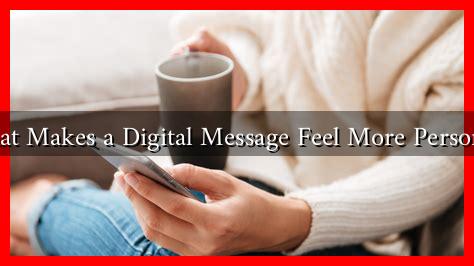-
Table of Contents
What Makes a Digital Message Feel More Personal?
In an age where digital communication dominates our interactions, the challenge of making messages feel personal has never been more critical. Whether it’s an email, a text, or a social media post, the ability to connect on a personal level can significantly enhance engagement and foster relationships. But what exactly makes a digital message resonate on a personal level? This article explores the key elements that contribute to a more personalized digital communication experience.
The Importance of Personalization
Personalization in digital messaging is not just a trend; it’s a necessity. According to a study by Epsilon, 80% of consumers are more likely to make a purchase when brands offer personalized experiences. This statistic underscores the importance of tailoring messages to meet the individual needs and preferences of the recipient.
Key Elements of Personalization
To create a digital message that feels personal, several key elements should be considered:
- Use of Names: Addressing the recipient by their name can significantly enhance the personal touch. It creates a sense of familiarity and connection.
- Tailored Content: Customizing the content based on the recipient’s interests, preferences, or past interactions can make the message feel more relevant and engaging.
- Emotional Tone: The tone of the message plays a crucial role. A warm, friendly tone can evoke emotions and make the recipient feel valued.
- Visual Elements: Incorporating images or videos that resonate with the recipient can enhance the personal feel of the message. Visuals can evoke emotions and create a stronger connection.
- Timeliness: Sending messages at the right time, such as on birthdays or anniversaries, can make the recipient feel special and appreciated.
Examples of Personalization in Action
Many brands have successfully implemented personalized messaging strategies. Here are a few notable examples:
- Amazon: The e-commerce giant uses sophisticated algorithms to recommend products based on users’ browsing and purchase history, creating a tailored shopping experience.
- Netflix: By analyzing viewing habits, Netflix provides personalized recommendations, making users feel understood and catered to.
- Spotify: The “Discover Weekly” playlist is a prime example of personalized content, offering users a curated selection of music based on their listening preferences.
Case Study: The Impact of Personalization
A case study conducted by Forbes highlighted a retail company that implemented personalized email marketing campaigns. By segmenting their audience and tailoring messages, they saw a 25% increase in open rates and a 15% increase in click-through rates. This demonstrates the tangible benefits of personalization in digital messaging.
Challenges in Personalization
While personalization is essential, it comes with its challenges:
- Data Privacy Concerns: With increasing awareness of data privacy, consumers are wary of how their information is used. Brands must navigate these concerns carefully.
- Over-Personalization: There is a fine line between personalization and intrusion. Messages that feel too tailored can make recipients uncomfortable.
- Resource Intensive: Creating personalized content requires time and resources, which can be a barrier for smaller businesses.
Conclusion
In conclusion, making a digital message feel personal is a multifaceted endeavor that requires attention to detail and an understanding of the recipient’s needs. By incorporating elements such as the use of names, tailored content, emotional tone, visual elements, and timeliness, brands can create messages that resonate deeply with their audience. While challenges exist, the benefits of personalization—enhanced engagement, loyalty, and ultimately, conversions—make it a worthwhile investment. As digital communication continues to evolve, those who master the art of personalization will stand out in an increasingly crowded marketplace.


